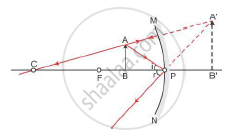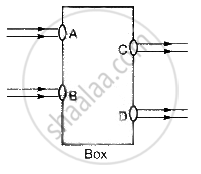Advertisements
Advertisements
Question
It is desired to obtain an erect image of an object, using concave mirror of focal length of 12 cm.
Will the image be smaller or larger than the object? Draw ray diagram to show the formation of image in this case.
Solution
The image will be larger than the object (enlarged).

APPEARS IN
RELATED QUESTIONS
To construct a ray diagram we use two rays of light which are so chosen that it is easy to determine their directions after reflection from the mirror. Choose these two rays and state the path of these rays after reflection from a concave mirror. Use these two rays to find the nature and position of the image of an object placed at a distance of 15 cm from a concave mirror of focal length 10 cm.
A spherical mirror produces an image of magnification −1 on a screen placed at a distance of 40 cm from the mirror:
(i) Write the type of mirror.
(ii) What is the nature of the image formed?
(iii) How far is the object located from the mirror?
(iv) Draw the ray diagram to show the image formation in this case.
The radius of curvature of a spherical mirror is 20 cm. What is its focal length?
If the focal length of a convex mirror is 25 cm, what is its radius of curvature?
Draw ray-diagrams to show the formation of images when the object is places in front of a concave mirror (converging mirror):
(i) between its pole and focus
(ii) between its centre of curvature and focus
What kind of mirror can have a focal length of, −20 cm?
At what distance from a concave mirror of focal length 10 cm should an object be placed so that:
its real image is formed 20 cm from the mirror?
Beams of light are incident through the holes A and B and emerge out of box through the holes C and D respectively as shown in the figure. Which of the following could be inside the box?

For a real object, which of the following can produce a real image?
The ENT doctor uses a ______.
